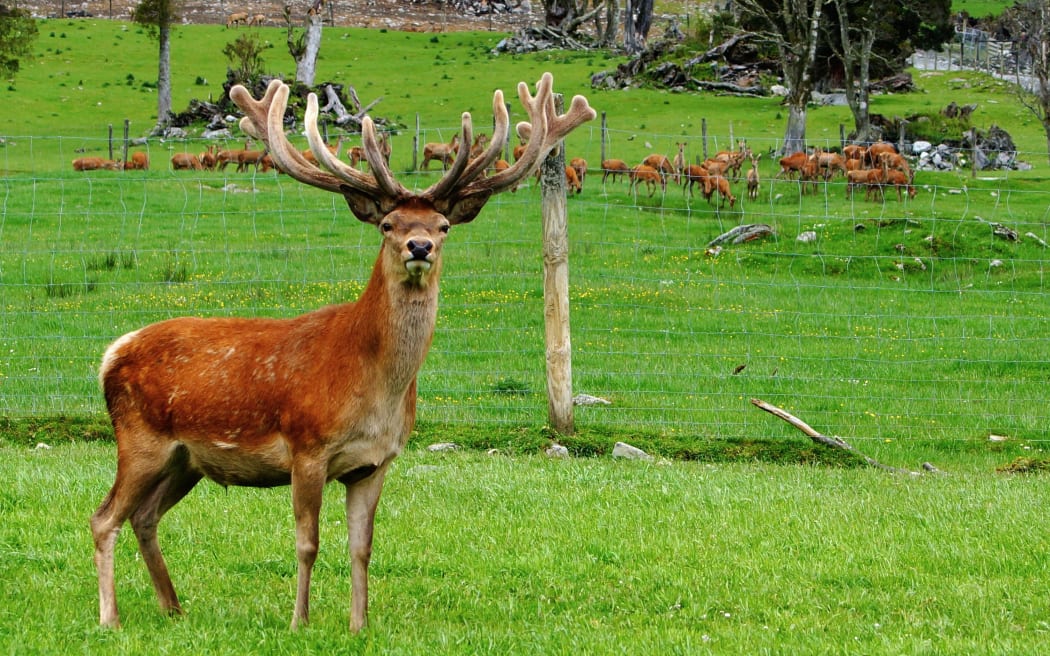By Jennifer Chesak, BBC

(File photo.) Photo: 123rf
Recent cases of humans contracting sporadic Creutzfeldt-Jakob disease (CJD) have raised questions about whether a disease carried by deer may be jumping the species barrier.
"Zombie deer disease" is spreading among wildlife. But scientists have not reached an agreement on whether the condition - also known as chronic wasting disease - can spread to humans and lead to a form of Creutzfeldt-Jakob disease (CJD).
Chronic wasting disease, or CWD, is a type of prion disease, according to the Centers for Disease Control and Prevention in the United States. It is a neurodegenerative condition that infects wildlife, including deer. It has most recently been confirmed in deer, as well as moose in Canada, after previous cases were reported in Yellowstone National Park in the United States.
No cases have yet been reported in humans, but a recent medical case report by doctors in Texas, US, on the deaths of two hunters who regularly ate meat from a population of deer infected with CWD has raised fresh questions about a link with human prion disease. Both men died of CJD, but doctors investigating the deaths were unable to prove a definitive link to CWD. They urge for the need for increased surveillance and research to establish whether the disease can cross over into humans.
As transmissions in animals increase across North America, Scandinavia and South Korea, some experts fear the risk of transmission to humans may also be increasing. They base their concerns on experimental studies, the history of other prion diseases transmitting from animals to humans (which is extremely rare) and the potential impacts of climate change.
"As of yet, there has been no transmission from deer or elk to humans," says Jennifer Mullinax, associate professor of wildlife ecology and management at the University of Maryland. "However, given the nature of prions, CDC and other agencies have supported all efforts to keep any prion disease out of the food chain."
This is what we currently know about CWD.
What is zombie deer disease and what are the symptoms?
Chronic wasting disease is transmitted in cervids, which are hoofed ruminant mammals, such as deer, reindeer, elk and moose. Although it is an infectious disease, CWD is not caused by a bacterium or a virus, according to the US Department of Agriculture's Animal and Plant Health Inspection Service.
Instead, a misfolded prion protein causes the issue, but researchers don't yet know what causes the protein to become abnormal. Normal prion proteins potentially play a role in cell signalling. But when misfolded, they cause more proteins to misfold.
Misfolded prion proteins in the brain kill brain cells and cause bodily dysfunction, leading to unusual symptoms. Symptoms include weight loss, excessive drinking and urination, poor balance and coordination, drooping ears and difficulty swallowing. The difficulty swallowing can lead to drooling and eventually pneumonia and death. The classic symptoms - and the image of an uncoordinated, stumbling and drooling animal - have led to the term "zombie deer disease". The symptoms can take months or years to manifest, making a visual diagnosis difficult.
When prion proteins are misfolded, they become infectious, which leads to spread among wildlife. CWD spreads from animal to animal through direct contact with bodily fluids and waste and through indirect contact with contaminated soil, water and food.
Can zombie deer disease spread to humans?
The CDC estimates that in areas where the prion disease is endemic, infection rates range from 10 percent to 25 percent. In 2023, surveillance results from the Canadian province of Alberta suggest a 23 percent positivity rate for mule deer.
Current evidence does not show that CWD can be spread to humans when they eat the meat of an infected animal, encounter infected wildlife, or drink or touch contaminated soil or water. But researchers continue to investigate whether animal-to-human transmission is possible. "The current body of research is a mixed bag, meaning we don't know yet," Mullinax says.
Older research from the CDC, published in 2011 used the Foodborne Diseases Active Surveillance Network 2006-2007 population survey to assess exposure risk. The survey included results from more than 17,000 participants. More than 65 percent of the total respondents reported eating wild game at least some of the time. The researchers were looking only at the prevalence of potential exposure, but they reported that no evidence of human transmission had been found to date.
However, prion diseases, also called transmissible spongiform encephalopathies, are present in humans. These include Creutzfeldt-Jakob Disease, which is an inherited condition, and variant Creutzfeldt-Jakob disease. The latter, researchers have now confirmed, is caused by the same infectious agent that leads to bovine spongiform encephalopathy, or BSE, also called "mad cow" disease.
Variant Creutzfeldt-Jakob disease, or vCJD, was first discovered in 1996, in the United Kingdom. But mad cow in cattle was discovered about a decade prior. About 230 cases of vCJD have been reported globally across 12 countries.
"The situation with vCJD - caused by zoonotic transmission of the BSE prion from consuming infected beef - serves as perhaps the best example of what a potential crisis of CWD transmission to humans could look like, says Michael Osterholm, director of the Center for Infectious Disease Research and Policy (CIDRAP) at the University of Minnesota.
"However, it's important to note that BSE and CWD prions differ structurally and we do not yet know whether the pathology and clinical presentation would be comparable if CWD transmission to humans were to occur," he adds.
In 2004, CDC researchers looked at cases of the human prion disease CJD in Wyoming and in Colorado from 1979 to 2000. The latter state is where CWD was first discovered in 1967. The researchers were partly investigating whether non-inherited cases were present and if they were related to zombie deer disease. Colorado reported 67 cases of CJD, and Wyoming seven. The incidence of CJD in these states proved similar to that of the rest of the United States. And the researchers report that, at the time, only two non-familial cases of CJD in people who ate venison in endemic areas had ever been reported.
Although CJD is generally an inherited disease, it was also previously transmitted through medical procedures. However, no cases of this type of transmission have been reported since the mid-1970s when better sterilization procedures were implemented, according to the CDC.
While older studies did not uncover definitive evidence of animal-to-human transmission of CWD, that doesn't rule out the possibility. Newer research has raised concerns.
What experimental studies of chronic wasting disease show
"Lab-based and animal-based testing have had mixed results depending on the species and methods used to attempt transmission," Mullinax says. "What we know so far is that each species has a unique level of resistance or a barrier to infection by CWD prions, and species more closely related to humans have been completely resistant."
In a 2018 study conducted by the National Institutes of Health, researchers exposed 14 macaques, which share about 93 percent of their genome with humans, to CWD-infected brain matter from deer and elk. They monitored the macaques for more than a decade, screening tissue through various tests. They found no evidence of transmission from the infected cervid tissue to the macaques. However, other experimental research, some unpublished, suggests possible transmission from cervids to macaques.
In an experimental study from the University of Calgary in 2022, researchers took CWD isolates from infected deer and injected them into "humanised" mice. Humanised mice are those that have been genetically modified for the purpose of exploring or modelling human diseases. Over 2.5 years, the mice developed CWD and shed infectious prion proteins in their waste. The researchers note that the mice developed an atypical prion signature and suggest that if CWD is transmissible to humans, it may manifest with atypical symptoms, making it hard to diagnose. The researchers also raise the concern about faecal shedding in the mice. If animal-to-human transmission ever proved possible, an infected person could spread it to others.
"These studies also come with inherent limitations that further complicate the interpretation of results," Osterholm says. "When assessing the latest scientific publications on this topic, there is not sufficient evidence to confidently conclude 'yes' or 'no' to the question of CWD breaching the species barrier."
What's being done about surveillance of chronic wasting disease?
CIDRAP has assembled a group of experts to develop a contingency plan should CWD prove to spill over to humans. The team is actively monitoring the risk. And researchers at the University of Pennsylvania School of Veterinary Medicine's Wildlife Futures Program have been analysing the gut microbiota of both non-infected and CWD-infected deer for enhanced surveillance and to learn more about the disease.
"Many academic and United States Department of Agriculture (USDA) researchers are working on potential live tests for CWD," Mullinax says, "which would be an incredible help to mitigate the potential for humans consuming infected deer. Meanwhile, we will keep trying to better understand how CWD prions might mutate and what animals, including us, could be impacted."
Experts do raise concerns about the possibility of CWD changing over time. "Ongoing transmission in cervids can also facilitate the emergence of novel CWD prion strains," Osterholm says, "which might have the capacity to infect a different range of hosts."
Likewise, climate change could play a role. "Research on the impacts of climate change on deer suggests deer populations will increase in response," Mullinax says.
* This article was originally published on 20 February 2024. It was updated on 19 April 2024 to include details of the medical case report into two hunters who died from CJD.
- BBC



